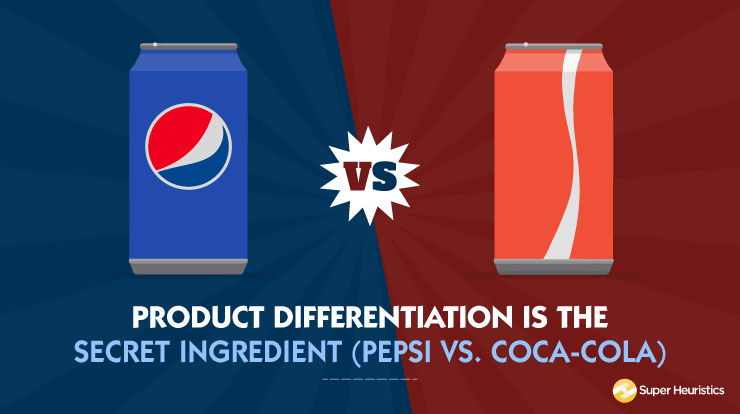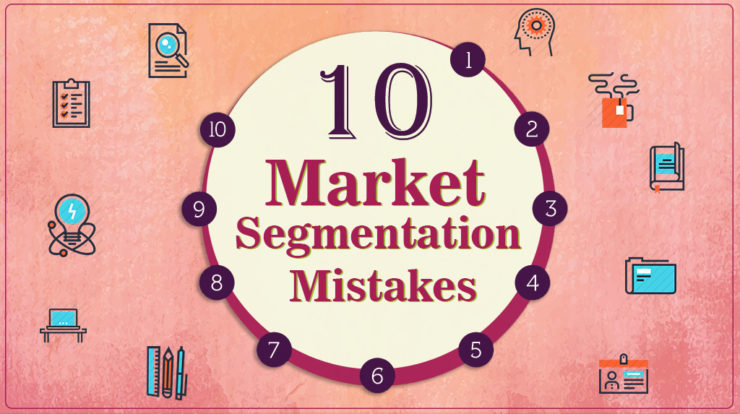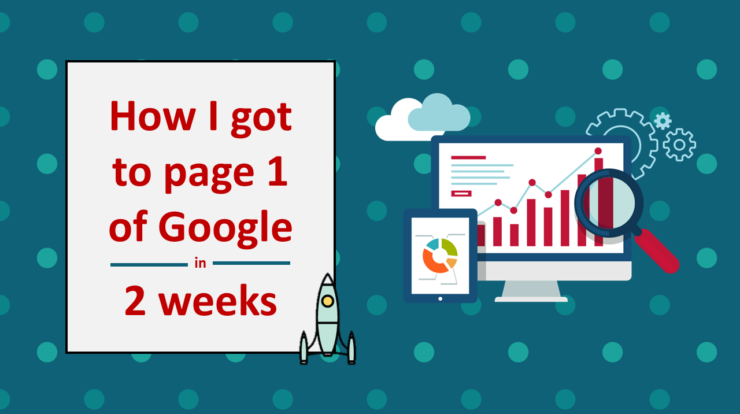
July 2018 Update – Google has changed the name of Google Adwords and all the other google ad properties to ‘Google Ads’.
In this post, I will be telling you about how two of my blog posts currently rank on page 1 of Google and why it means a great deal to anyone who runs a blog or a website.
If you searched Google for ‘market segmentation mistakes’ right now, you would see my blog post show up on page 1 of Google at position number 2:
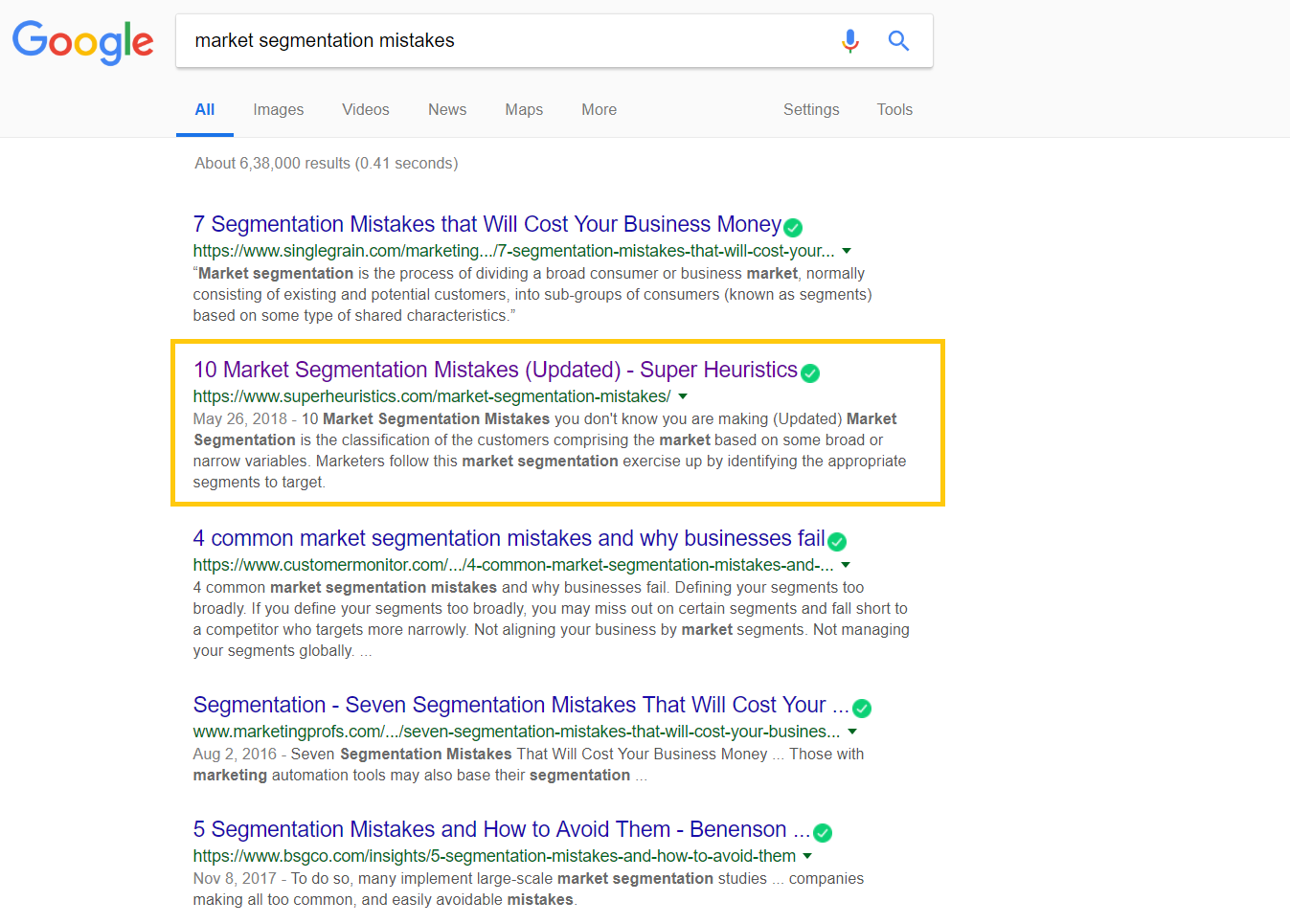
It currently ranks number 2 in 6,38,000 search results for that keyword from searches in India.
If you searched the same keyword ‘market segmentation mistakes’ on mobile, chances are that you may see my blog in the first result in the ‘answer snippet’ or the ‘summary snippet’ of Google.
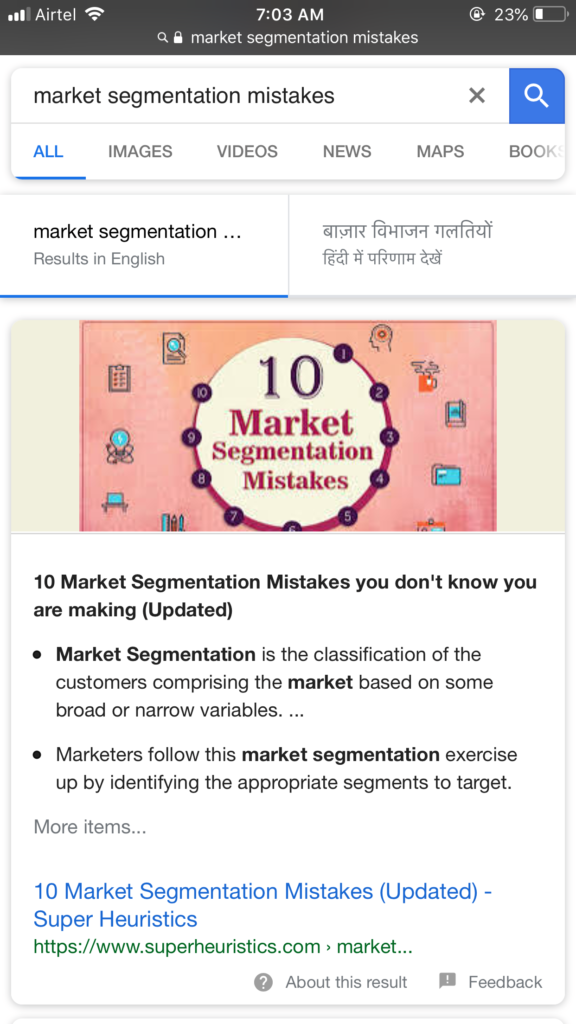
This answer snippet is a snippet extracted programmatically from what a visitor sees on the web page. Google programmatically detect pages that answer the user’s question and display a top result as a featured snippet in the search results.
If you also happen to search Google for an extremely pertinent question, ‘difference between market research and market analysis’, which almost anybody starting out in the field of marketing would have confusion about, here’s what you would see.
My blog post on the same topic ranks on page 1 at position 9 out of 56,60,00,000 results on Google:

Also, it is worth quickly mentioning here that Google’s recent algorithms have made the rankings extremely dynamic because of which the rank of any search result may differ by 1 to 3 positions in each subsequent search query.
Therefore, my first article features anywhere between rank 1 to rank 4 on page 1 of Google (based the location of the user, the device etc.) and the second article does slip up to as high as rank 2 on page 1 of Google on some searches.
So, what’s the context? What makes me share this with you?
It is the fact that organic SEO takes at least 4 to 6 months to show results for any keyword you may rank your page for.
And that’s exactly the condition of all the other blog posts that I have on my blog. They are taking their time to rank. In fact, any top 10 ranking post on Google is on an average at least 2 years old.
Sure, people do expedite this process by using some of the most illicit methods out there, clubbed together under the name Black Hat SEO techniques. It makes them reach page 1 in one crawl of the Google Webmaster.
However, with the recent Google Pagerank updates, such practices are caught easily and the damages are lethal. Google punishes you hard for any Black Hat SEO techniques you have used.
For a start, your website vanishes from the entire ranking in the next Google crawl. Further, in most of the cases, the domain name is blacklisted by Google and is never ranked respectfully ever again.
The first article on 10 Market Segmentation mistakes reached page 1 for the first time on 30th April 2018 on rank 10, which is the last search item on page 1 of Google.
Since then, with all the clean White Hat SEO techniques that I applied, its ranking has increased to the current rank of 2. It has remained on that position for over two months now.
Why is page 1 of Google so important?
Over 93% of online experiences begin with a search. And if it’s about search visibility what better place to be than on page 1 of Google. You need to reach out to the people at the time when they are searching for the information they are in need of.
Moreover, search traffic visitors are known to appreciate your website better than what paid traffic visitors are known to do. A user coming in from search traffic is more likely to stick to your website for longer, visiting multiple pages and therefore decreasing the bounce rate.
This is because while you can put in any amount of rupees on paid channels like Facebook to target almost any kind of audience (regardless of whether they should be your target or not), advanced Google search algorithm of 2018 will ensure that your post reaches only those who are searching for exactly that topic or anyone searching for something in the similar context.
Finally, organic is the way to go to really make your blog or website sustainable in the long run. There is only a certain amount of paid marketing you can do either as a solo entrepreneur blogger or even as a marketing person of a multinational.
There is only a certain amount of rupees you can spend on your Facebook or on the email campaigns or for that matter on AdWords.
Running your blog entirely on Facebook or Email marketing, while your organic traffic is negligible compared to the paid traffic, is like running it on a ventilator.
The traffic would collapse the moment you pull the plug and stop feeding your campaigns with money.
Personally, for me, as a person who is running this blog at a bare minimum budget, organic is the way to go to ensure that traffic keeps coming in without burning a hole in my pocket.
So, How did I get them on page 1 of Google?
Coming back to the point, what was it that made all the difference and brought me to the page 1 of Google?
Here are some of the strategies that made it happen for me:
1. Long-tail keywords do work
Long-tail keywords are those keywords which have more than 3 words in it. These are different from the normal keywords primarily on the basis of the length and therefore on the basis of specificity of the search that happens when a long-tail keyword is used.
To understand what is a long-tail keyword and how does it help with improving search specificity consider the following example.
Short keyword: What is differentiation
Long-tail keyword: What is differentiation in marketing with an example
The short keyword in this example has a really broad scope in terms of the contexts that Google needs to look into.
It must be noted that differentiation is also the mathematical/calculus operation that is taught to students in senior secondary school.
In this case, ranking your marketing article for the short keyword ‘What is differentiation’ not just brings in competition from established marketing blogs but also from some great blogs on mathematics and calculus.
Therefore, long-tail keywords make it more specific and help you to avoid competition that you can avoid while being laser sharp with your keywords.
For my article on Market Research vs. Market Analysis, the keyword that I ranked it for was a long-tail keyword which was ‘difference between market research and market analysis’.
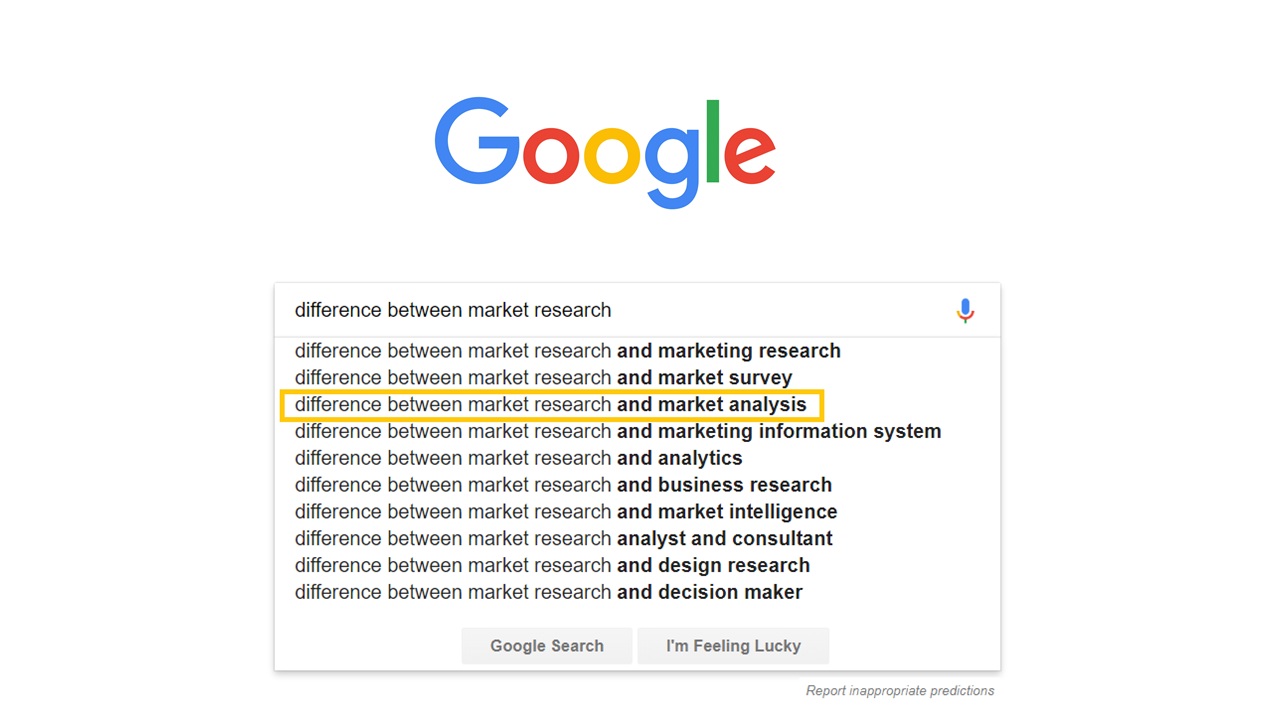
Google predictive text gives you a decent idea of what topics are being searched by users. Further, a keyword tool such as Google Keyword planner must be used to find what sort of competition is there for that particular keyword.
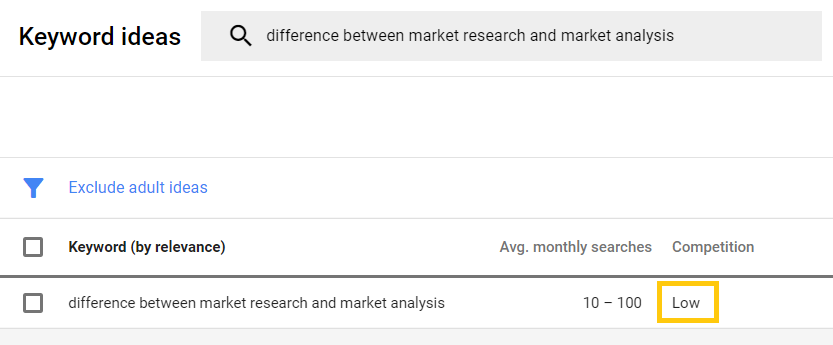
One of the greatest reasons (and also the most basic one) for making it to page 1 of Google so early is that I chose a keyword which was low on competition, i.e. no or extremely low number of people were betting their pages on the same keyword.
2. But, do ONLY long-tail keywords work?
The answer is a clear NO.
While long-tail keywords will help you win the search ranking battle almost every time, it is no such thing that you can not use short keywords if you wish to rank on page 1 of Google.
My blog post on 10 Market Segmentation mistakes is the best example of this. I ranked this blog post on the keyword ‘market segmentation mistakes’. This doesn’t really qualify as a long-tail keyword as long it is three words.
But then what makes Google rank me for this keyword as the 5th search item on Page 1?
What makes it happen is Google’s ability to understand the context of the blog post’s content and the context of your overall website and ensuring that any search query looking for content on that particular context gets that blog post early on in the search.
Which brings me to my next point.
3. Write content for the people and not for SEO
Gone are the days when a sure fire way of getting your page to rank higher was to stuff your pages with your focus keyword, sort of indicating Google that your page is the most relevant page for that search term.
As a matter of fact, there is enough speculation that with the new Google algorithm updates, Google might penalize you for keyword stuffing as it is a classic Black Hat SEO technique.
Keyword stuffing is you writing your content for the search engines and the algorithm and not for the people who are going to read them. Consider yourself reading an article that is clearly repeating a phrase over and over again, isn’t that frustrating?.
Take a look at this, my market segmentation mistakes article which ranks on page 1 of Google has a keyword density of as low as 0.5%!

The idea is to write content for the people who are going to read it and not for the purpose of the SEO. The article should have one strong unifying theme and you can bet that Google would understand what the context of the article is.
Another, thing that helped me win this battle was my long form of content. The market segment article of mine is as long as 2955 words!
This is the longest article on the entire page 1 of Google right now.
This helped me or would help anyone in two ways.
- It gives Google an impression that there is a lot more information in this article than on the shorter forms of articles out there and therefore this needs to be showing higher than most of them.
- And, it gives the reader an assurance that he or she is going to get an exhaustive and detailed analysis of the topic. They keep coming back and your rank keeps on getting boosted.
In fact, none of my blog posts are less than 1300 words. The idea is to keep them long and detailed and full of enriching content.
4. Have ‘strategic’ pages with a high keyword density
So just right now I mentioned how you should avoid doing keyword stuffing completely. Also, I showed you how my blog posts have a keyword density of 0.5%.
But I am going to tell you something exactly opposite, that is you should have a really high keyword density on your pages. That is the only way you can guarantee that Google is going to rank you for that keyword.
Yes, that is correct, I just said that you should do keyword stuffing.
But didn’t I just strictly advise you against it in the point above?
I did. And here is what it means. You create blog posts as knowledge material for your readers. That is, in some sense, your product. And you definitely need to ensure that you deliver a terrific product experience.
Wouldn’t it be tacky if you keep on reading the same catch-phrase 30 times in a 1000-word post? It would be.
Here’s what I did. I created strategic pages. Pages where I could do all the keyword stuffing that I wanted to do till my heart’s desire.
One of the most useful strategic page that every blog or website has, but is terribly ignored from an SEO perspective, is the About Us/About Me page.
On pages like these, I ensure that I put my keywords a hell lot of times so that the overall domain ranking (and not any specific page ranking) goes up.
Here’s my About page with a keyword density of not 0.5 or 1%, but as much as 7%!:
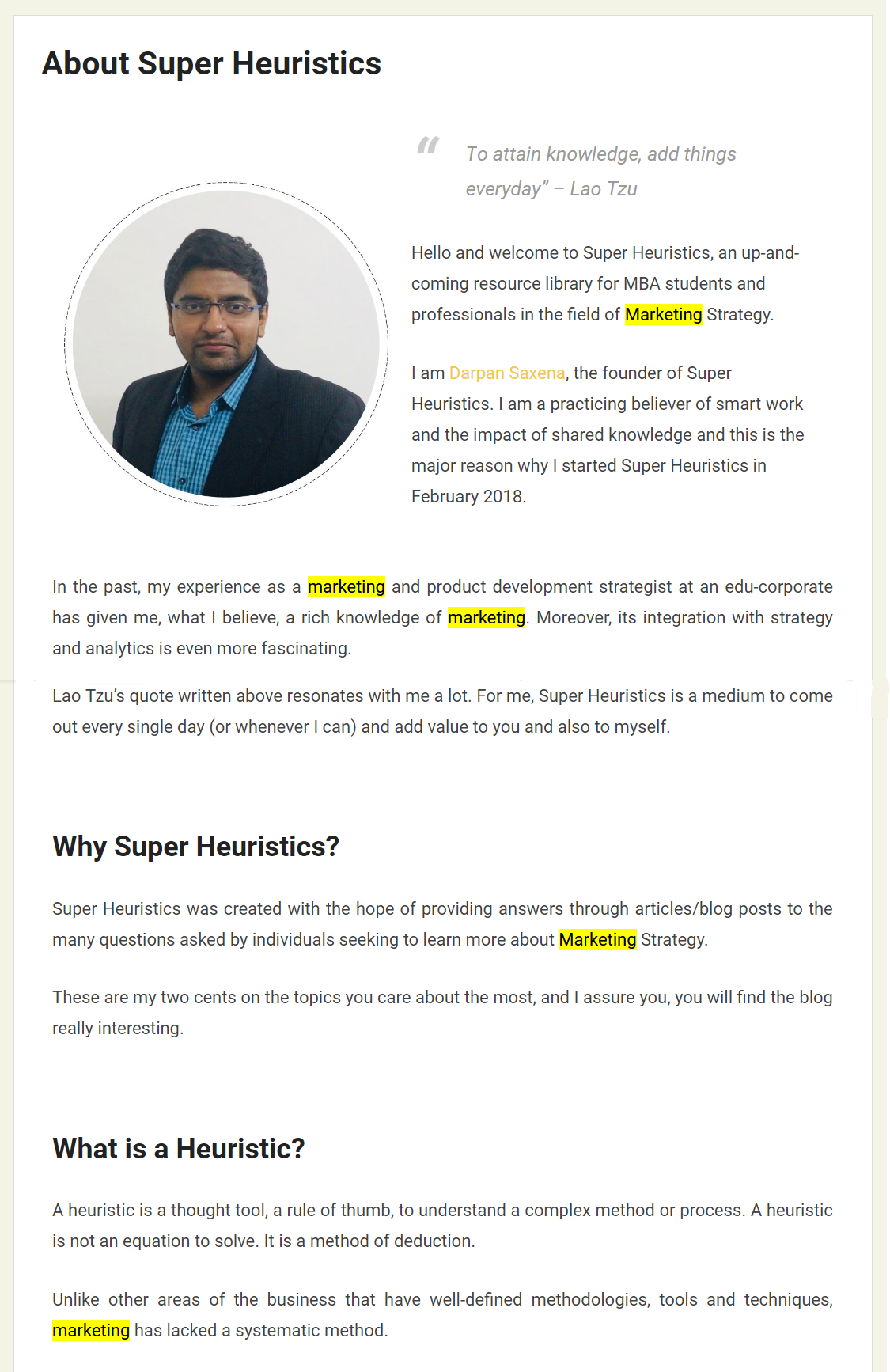
I stuffed this page with my main keyword ‘marketing’ an awful number of times. This helps in gearing up my pages for any individual blog post on Marketing.
This was this. But the next two things that I did are the most amazing ones and I feel that these are the ones that truly made all the difference at the end of the day.
5. Borrowing titles and meta descriptions from Google Ads
For almost any topic that you search on Google, the page 1 of Google will most likely contain two or three search results that have paid to be there on the top.
These are AdWords ads and these are marked by a little ‘Ad’ tag like this

Now, while you are only shown two ads here, you must know that these were definitely not the only two websites that paid for getting to this spot on Google. In fact, there would be at least 100 others (if not 1000s) who have currently bid for this position but Google decides to place these two on the top.
Why is that?
Because Google observed that out of all those 100 ads on mobile phones, people had been clicking on these two ads the most. And therefore, these two ads need to be on the top.
Sure, you would say that these two are up there because Amazon and Flipkart have a high domain authority but AdWords doesn’t really depend on domain authority that much.
What does it mean for you?
The take away for you is that these title tags and meta description used by these two sites are so good that people are attracted to click on them.
So if you are a mobile phone seller, you must consider taking a leaf out of their book. Therefore, you must consider creating your page title and meta description in a similar manner (if not the same) as these two ad pieces which have beaten the heavy competition purely on the basis of their title and meta description attractiveness.
6. Death by Content
All of what I explained above ensured that my market segmentation mistakes article reaches page 2 by the end of the first week after I published the article for the first time.
All these were the basic hygiene factors with which I made sure that with the low domain authority disadvantage that I have, I still make it to page 2 or page 3.
What I did then that finally secured my position on page 1 in the very next week was – death by content. That is, out doing all the other search results that rank higher than you by the amount of relevant content.
Here’s a trivia – only the ardent followers of my blog would know that my 10 Market Segmentation Mistakes article was initially not 10 but 3 Market Segmentation Mistakes.
While I was offering just 3 market segmentation mistakes, all the other posts on page 1 for my keyword were offering more. 4, 5, 7 market segmentation mistakes.
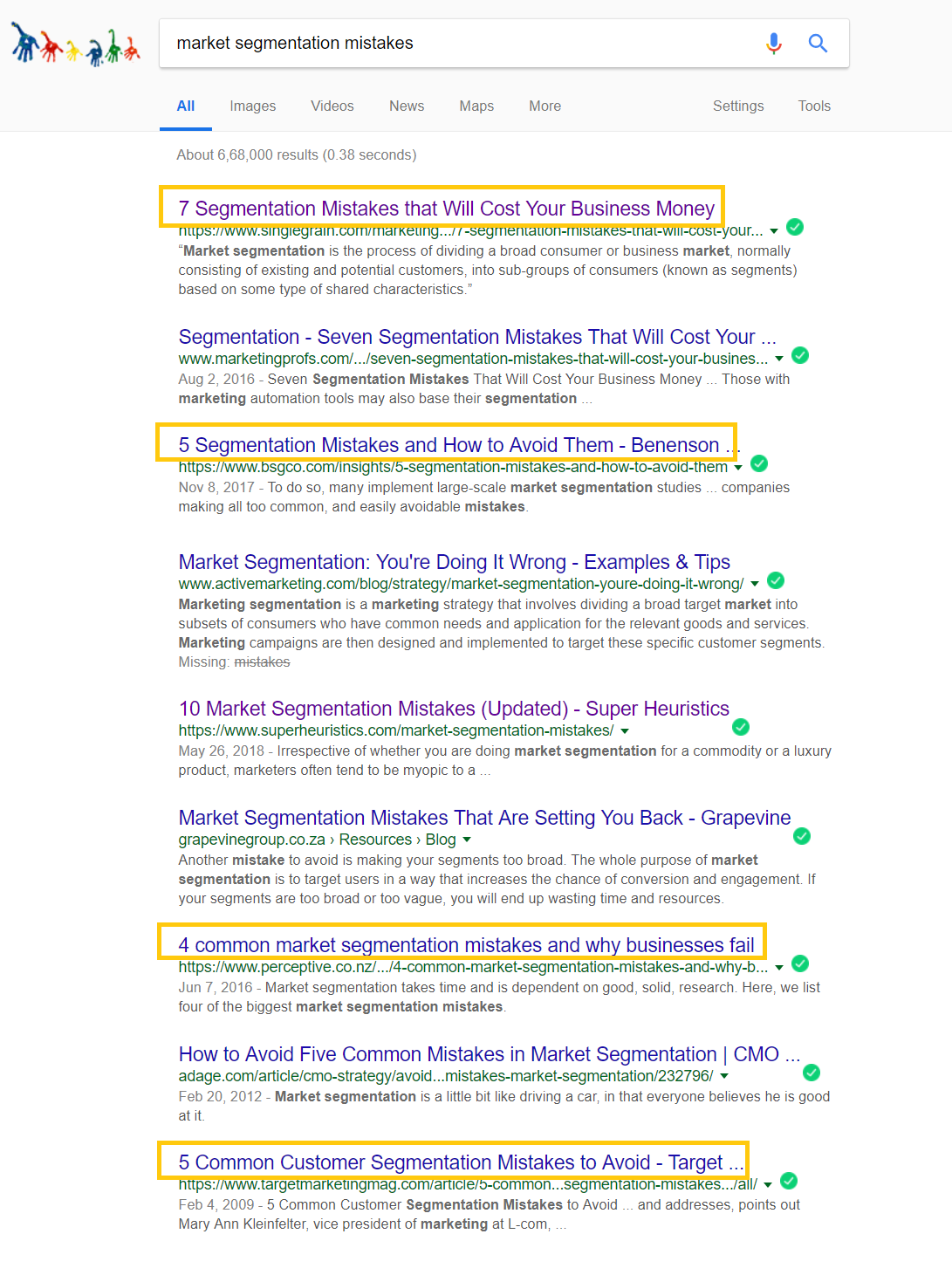
This makes a difference in how the users perceive your content. If I, as a user, have searched for market segmentation mistakes, I would be more tempted to click on a post that offers me more points than just 3 points.
Therefore, after the end of the first week, extended my article and made it 10 Market Segmentation Mistakes which was higher than anyone else was offering.
Original Title: 3 Market Segmentation mistakes you don’t know you are making
New Title: 10 Market Segmentation mistakes (Updated)
As soon as people see 10 as opposed to 3, 4, 5 or 7, and that too with ‘Updated’ in the title, there would be a perception that this article is more relevant, more current. And such a feeling is very rational.
Results
The page rank for these two blog posts went up to where they currently are within 2 weeks of me publishing them.

It obviously did impact the kind of traffic that I was getting on to my blog. My organic search traffic grew from 1.9% of the total traffic to 11% of the total traffic in those same two weeks.
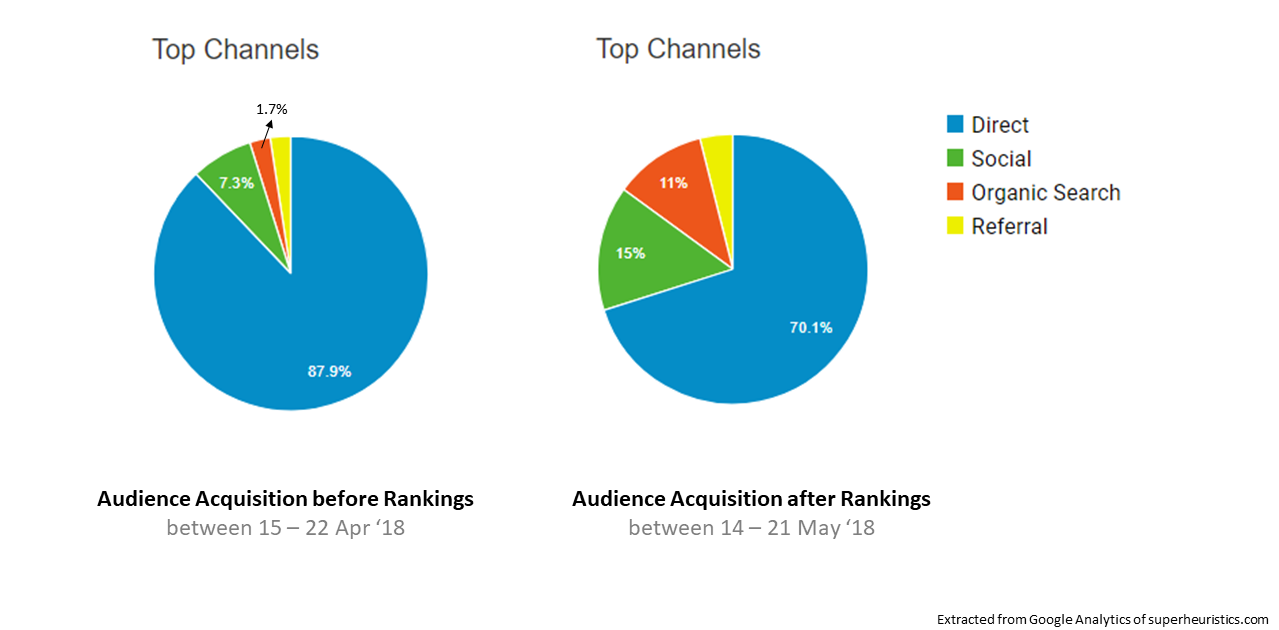
Most of it was still direct traffic that was coming from my friends or from the mailers that I was sending. But for a small, upcoming blog like mine, an increase from 1.7% to 11% was a big deal.
What did I not mention here?
I have skipped a couple of things on purpose. Most of them are the basic hygiene factors that you need to ensure before you can expect anything to happen with your rankings.
This includes a ton of basic things; things as basic as submitting your website to Google search console. Beyond that, things like ensuring that the title and meta description of your website is in place, your website is mobile responsive, your website has a lot of content on it already, your sitemap is active and many other things.
So while what I have discussed did help me get the kind of rankings that I have for these two blog posts, that is not the first step in getting here. There is a lot of pre-work, of months and months together, that go before it to make it happen.
Conclusion
Getting a high rank on Google is a matter of a lot of work that goes in. Firstly, you need to ensure that your hygiene factors are in place and secondly, you need to work as per the situation in order to improve the rankings.
The hygiene factors take you only to a certain level in Google. Usually, this is nowhere above page 8-10, in my case I was lucky to get my Market Research vs. Market Analysis blog post directly on page 3. That too I will attribute to some of the work that I did before that.
In this blog post, I explained how two of my blog posts are currently at #5 and #12 in Google rankings and how it improved my search traffic.
In the subsequent posts, I will bring out more such case studies of other pages of mine that are slowly and steadily growing up the charts.


